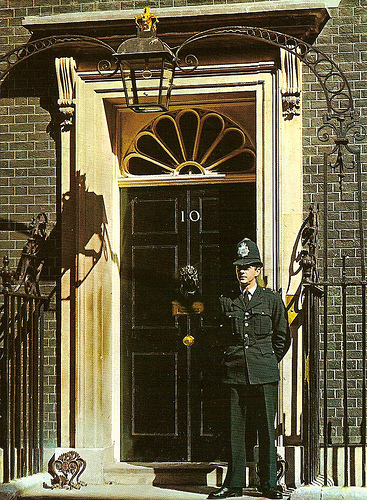10 Downing Street
10 Downing Street is the instantly recognisable address of the office of the Prime Minister, and has been since 1735. It is behind the doors in this regular looking house that many of the major decisions that have affected the UK have taken place. It was from here that operations during both World Wars were directed and decisions about the British Empire were made. The address has seen many famous and infamous residents come and go, from Robert Walpole and Pitt the Younger through to Winston Churchill and the UK’s first female Prime Minister; Margaret Thatcher.

Number 10 Downing Street is much more than a simple residence or office though, as it serves many more functions. It is a reception place for major international dignitaries and is where the Prime Minister receives the Queen. It is the site of gala receptions and international dinners, and is of course much larger on the inside that it appears from outside that shiny black door. The house which stood at 10 Downing Street was enlarged and joined with the 18th century building which lay behind it; it encompasses much of number 12 too, with a corridor connecting it to Number 10 which runs through the residence of the Chancellor of the Exchequer at Number 11.
History of Number 10
The Axe Brewery, a business which had fallen into disrepair by the early 1500’s, was what stood on this site during the middle ages. However, with the building of the Palace of Westminster and Whitehall Palace increasing in importance when Henry VIII moved his court there the whole area grew in prestige; Downing Street sits on the edge of what was the original palace site. With royalty making their home here it was only natural that the area would attract the rich and powerful. The first house to be built on the site was lived in by Sir Thomas Knyvet, the man responsible for the arrest of Guy Fawkes. Upon his death the building passed to his niece until the building was returned to the crown.
The street itself is named after George Downing, and he too is responsible for the building that we recognise today. A former diplomat, he secured purchase of the residences here as a way of turning a profit, he then turned the redesigning of the buildings over to Sir Christopher Wren. However well designed they may have been, they were very badly built as Downing aimed to maximise his profit as much as possible. What we recognise as number 10 was originally number 5 as there was no sense to the way the street was originally numbered, it became number 10 in 1779. The last private resident to call number 10 their home was a Mr Chicken who left Downing Street during the 1730’s. It was Robert Walpole who served as the country’s first Prime Minister that was next to occupy the property. He started a series of renovations and expansions that would be continued over the following centuries.
A Famous Resident
There is one resident of No 10 that has earned the adoration and love of the public more than any resident Prime Minister ever could: Larry the Cat. Larry carries the title of Chief Mouser, which was officially bestowed upon him. He has lived there for the past few years and came from Battersea Dog and Cat Home. He regularly receives gifts and treats from the adoring public, as well as from the teams of cameramen and reporters that regularly camp outside number 10.

